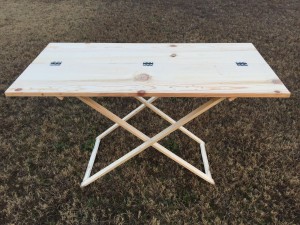 This clever little folding table is based on an extant 16th century example in the V&A. There is also a much nicer reconstruction here. As soon as I saw this table I knew I had to try my hand at making one. It seemed very simple and, in fact, it was. I spent about $30 on materials at Lowe’s and got the majority of the woodworking done in a couple hours. The wood was cheap (utility shelving and furring strips) and the construction is all screws (later hidden with putty). I plan to make a fancier version with better wood and proper mortise and tenon construction later, but this was sufficient to scratch the “gotta make it” itch.
This clever little folding table is based on an extant 16th century example in the V&A. There is also a much nicer reconstruction here. As soon as I saw this table I knew I had to try my hand at making one. It seemed very simple and, in fact, it was. I spent about $30 on materials at Lowe’s and got the majority of the woodworking done in a couple hours. The wood was cheap (utility shelving and furring strips) and the construction is all screws (later hidden with putty). I plan to make a fancier version with better wood and proper mortise and tenon construction later, but this was sufficient to scratch the “gotta make it” itch.
The trestle is made from the aforementioned 1 x 2 pine furring strips (the straightest I could cull from the pile), made into two rectangular frames with fairly slapdash application of screws. At the point where the two frames hinge together, I drilled a hole halfway through each leg and inserted a length of 3/8″ oak dowel for them to pivot on. This method of hinging is both expedient and unobtrusive.
To adjust the height of the trestle (and keep it from collapsing entirely), there are hooks on the underside of the top bar of each frame, between which are strung two lengths of chain. By shortening or lengthening the chain, the height of the trestle can be adjusted from normal table height to a comfortable counter or sideboard height. The hooks are made from pieces of coat hanger hammered into pilot holes. The original had rings on one side (to which the chins were permanently attached) and hooks on the other, with both rings and hooks driven all the way through the bar and bent over. If my hooks fail in the future, I may go back and do this myself.
The top is made from a 8′ 1 x 12 board cut into two ~48″ pieces. The two halves are joined by blackened 22ga steel hinges made in the same manner as my box hinges. They are attached using galvanized roofing nails as rivets. This was by far the hardest part of the construction process, as it was awkward maneuvering the boards into a position where the rivets could be properly supported on an anvil. The hinges are actually only held on by two rivets on each side; the middle rivets are just pounded into holes drilled halfway through the boards since they were not worth the effort to set properly.
I look forward to getting lots of use out of this table and the better ones that will surely follow.
folding trestle table.skp.zip (SketchUp)
